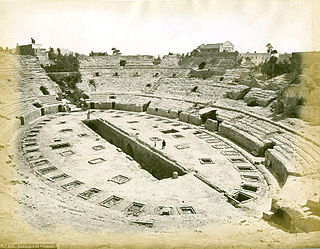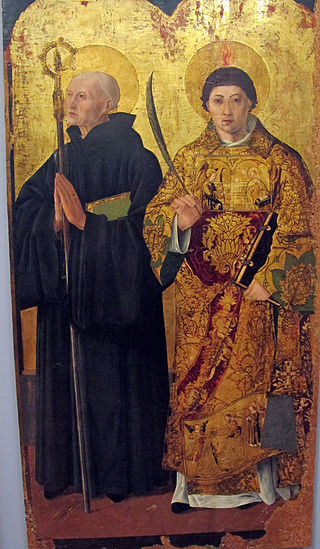Related Research Articles

Gavinus is a Christian saint who is greatly celebrated in Sardinia, Italy, as one of the Martyrs of Torres, along with his companions Protus, a bishop, and Januarius, a deacon.
Year 305 (CCCV) was a common year starting on Monday of the Julian calendar. At the time, it was known as the Year of the Consulship of Constantius and Valerius. The denomination 305 for this year has been used since the early medieval period, when the Anno Domini calendar era became the prevalent method in Europe for naming years.

Solfatara is a shallow volcanic crater at Pozzuoli, near Naples, part of the Phlegraean Fields volcanic area. It is a dormant volcano, which still emits jets of steam with sulfurous fumes. The name comes from the Latin, Sulpha terra, "land of sulfur", or "sulfur earth". It was formed around 4000 years ago and last erupted in 1198 with what was probably a phreatic eruption – an explosive steam-driven eruption caused when groundwater interacts with magma. The crater floor was a popular tourist attraction until 2017, as it has many fumaroles and mud pools. The area is well known for its bradyseism. The vapours had been used for medical purposes since Roman times.

Januarius, also known as Januarius I of Benevento, was Bishop of Benevento and is a martyr and saint of the Catholic Church and the Eastern Orthodox Church. While no contemporary sources on his life are preserved, later sources and legends claim that he died during the Great Persecution, which ended with Diocletian's retirement in 305.

Pozzuoli is a city and comune of the Metropolitan City of Naples, in the Italian region of Campania. It is the main city of the Phlegrean Peninsula.

The Feast of San Gennaro, also known as San Gennaro Festival, is a Neapolitan and Italian-American patronal festival dedicated to Saint Januarius, patron saint of Naples and Little Italy, New York.

Sep. 18 - Eastern Orthodox liturgical calendar - Sep. 20

April 20 - Eastern Orthodox liturgical calendar - April 22
John the Deacon was a religious writer and deacon, or head of a diaconate at the church of Saint Januarius in Naples. He flourished towards the end of the ninth and the beginning of the tenth century, and from his writings appears to have been a very learned and accomplished cleric. He wrote several historical works, important sources of information for the history of his time.
Saint Agrippinus (Arpinus) of Naples was a bishop of Naples and is venerated in that city as a saint. According to tradition, Agrippinus was the sixth bishop of Naples. He lived at the end of the 3rd century, and seems not to have been a martyr.
Miseno is one of the frazioni of the municipality of Bacoli in the Italian Province of Naples. Known in ancient Roman times as Misenum, it is the site of a great Roman port.

The Diocese of Pozzuoli is a Latin diocese of the Catholic Church in Campania, southern Italy. It is a suffragan of the Metropolitan Roman Catholic Archdiocese of Naples, like its other neighboring dioceses, Aversa and Ischia.

The Flavian Amphitheater, located in Pozzuoli, is the third-largest Roman amphitheater in Italy. Only the Roman Colosseum and the Amphitheatre of Capua are larger. It was likely built by the same architects who previously constructed the Roman Colosseum. The name "Flavian Amphitheater" is primarily associated with the Roman Colosseum.

Saint Severus was a bishop of Naples during the 4th and 5th centuries. He is considered the eleventh legitimate Catholic bishop of Naples, and the twelfth overall, succeeding Maximus. His episcopate ran from February 363 to April 29, 409, the traditional date of his death. Between the episcopates of Maximus and Severus, Zosimus, an Arian was established as Bishop, who was condemned as heretical by the Catholic Church.

Saint Sossius or Sosius was Deacon of Misenum, an important naval base of the Roman Empire in the Bay of Naples. He was martyred along with Saint Januarius at Pozzuoli during the Diocletian Persecutions. His feast day is September 23, the date, three days after his death, on which his corpse was translated to Misenum.
Trofimena is a female saint canonised in the Roman Catholic Church. Originally from the town of Patti in Sicily, the relics of Trofimena are venerated in the basilica in the town of Minori, Italy on the coast of Amalfi, southern Italy.

San Procolo is an early Gothic-style, Roman Catholic church and former monastery-hospital located on Via Massimo D'Azeglio #52 in central Bologna, region of Emilia Romagna, Italy.
Januarius usually refers to St Januarius, bishop of Benevento or Naples.

Saint Januarius in the Amphitheatre at Pozzuoli is a 1635-1637 oil on canvas painting by Artemisia Gentileschi. The work shows the moment that the Christian martyr Januarius and his followers are thrown to a group of wild animals in the amphitheatre in Pozzuoli - however, they lick the saint's feet rather than attacking him and Januarius is unharmed.

Saints Proculus and Nicea is a 1635-1637 painting by Artemisia Gentileschi of Proculus and Nicea. Along with Adoration of the Magi and Saint Januarius in the Amphitheatre at Pozzuoli, it was commissioned by Martín de León Cárdenas for the choir of Pozzuoli Cathedral, of which he was bishop. After around fifty years' restoration in Naples, the painting was returned to its original spot in May 2014 when the Cathedral reopened for worship.
References
- 1 2 3 4 5 6 7 8 9 10 11 12 13 14 15 Santi Procolo, Eutiche e Acuzio
- ↑ "Hieromartyr Januarius, bishop of Benevento, and his companions: Sosius, Proclus and Festus, deacons, Gantiol, Eutychius, Acutius, and Desiderius, at Puzzuoli (305)".
- ↑ "Miseno: The Church of St. Sossio".
- 1 2 3 "A SILVER MASTERPIECE OF 18TH CENTURY NEAPOLITAN STATUARY: ST. PROCULUS PATRON SAINT OF THE TOWN AND DIOCESE OF POZZUOLI". Campi Flegrei. Archived from the original on 2007-03-11.
- ↑ "Feast of the Dedication of St. John Lateran". St. Patrick Catholic Church. Archived from the original on 2007-02-06. Retrieved 2012-03-08.
- ↑ "Mostra – Romana Pictura, foto". Archived from the original on 2006-10-01. Retrieved 2008-04-03.